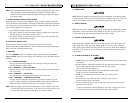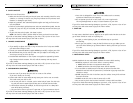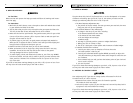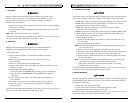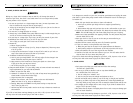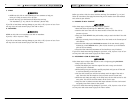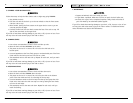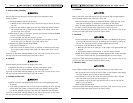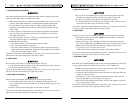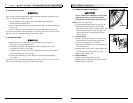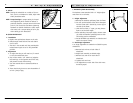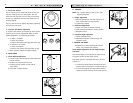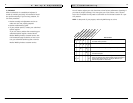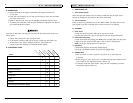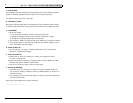
930469 Rev. A
VIII. Warnings: Components & Options
25
J. QUICK-RELEASE AXLES
1. Do not use this chair UNLESS you are sure that both quick-release rear axles
are locked. An unlocked axle may come off during use and cause a fall.
2. An axle is not locked until the quick-release button pops out fully.
An unlocked axle may come off during use, resulting in a fall, tip-over or loss of
control and cause severe injury to the rider or others.
If you fail to heed these warnings damage to your chair, a fall, tip-over or loss of con-
trol may occur and cause severe injury to the rider or others.
K. REAR WHEELS
A change in set-up of the rear wheels will affect the center of balance of your chair.
1. The farther you move the rear axles FORWARD, the more likely it is that your
chair will tip over backward.
2. Consult your doctor, nurse or therapist to find the best rear axle set-up for your
chair. Do not change the set-up UNLESS you are sure you are not at risk to tip over.
3. Adjust the rear wheel locks after you make any change to the rear axles.
a. If you fail to do so, the locks may not work.
b. Make sure lock arms embed in tires at least 1/8 inch when locked.
If you fail to heed these warnings damage to your chair, a fall, tip-over or loss of con-
trol may occur and cause severe injury to the rider or others.
L. REAR WHEEL LOCKS
Rear wheel locks are NOT designed to slow or stop a moving wheelchair. Use them only
to keep the rear wheels from rolling when your chair is at a complete stop.
1. NEVER use rear wheel locks to try to slow or stop your chair when it is moving.
Doing so may cause you to veer out of control.
2. To keep the rear wheels from rolling, always set both rear wheel locks when you
transfer to or from your chair.
3. Low pressure in a rear tire may cause the wheel lock on that side to slip and
may allow the wheel to turn when you do not expect it.
4. Make sure lock arms embed in tires at least 1/8 inch when locked. If you fail to
do so, the locks may not work.
If you fail to heed these warnings damage to your chair, a fall, tip-over or loss of con-
trol may occur and cause severe injury to the rider or others.
VIII. Warnings: Components & Options
930469 Rev. A
24
G. POSITIONING BELTS (OPTIONAL)
Use positioning belts ONLY to help support the rider’s posture. Improper use of these
belts may cause severe injury to or death of the rider.
1. Make sure the rider does not slide down in the wheelchair seat. If this occurs, the
rider may suffer chest compression or suffocate due to pressure from the belts.
2. The belts must be snug, but must not be so tight that they interfere with
breathing. You should be able to slide your open hand, flat, between the belt
and the rider.
3. A pelvic wedge or a similar device can help keep the rider from sliding down in
the seat. Consult with the rider’s doctor, nurse or therapist to find out if the
rider needs such a device.
4. Use positioning belts only with a rider who can cooperate. Make sure the rider
can easily remove the belts in an emergency.
5. NEVER Use Positioning Belts:
a. As a patient restraint. A restraint requires a doctor’s order.
b. On a rider who is comatose or agitated.
c. As a motor vehicle restraint. In an accident or sudden stop the rider may be
thrown from the chair. Wheelchair seat belts will not prevent this, and further
injury may result from the belts or straps.
If you fail to heed these warnings damage to your chair, a fall, tip-over or loss of con-
trol may occur and cause severe injury to the rider or others.
H. POWER DRIVE
Do not install a power drive on any Quickie wheelchair. If you do:
1. It will affect the center of balance of your chair and may cause a fall or tip-over.
2. It will alter the frame and void the warranty.
If you fail to heed these warnings damage to your chair, a fall, tip-over or loss of con-
trol may occur and cause severe injury to the rider or others.
I. PUSH HANDLES (OPTIONAL)
When you have an attendant, make sure that this chair has push handles.
1. Push handles provide secure points for an attendant to hold the rear of this
chair to prevent a fall or tip-over. Make sure to use push handles when you have
an attendant.
2. Check to make sure push handle grips will not rotate or slip off.
If you fail to heed these warnings damage to your chair, a fall, tip-over or loss of con-
trol may occur and cause severe injury to the rider or others.



